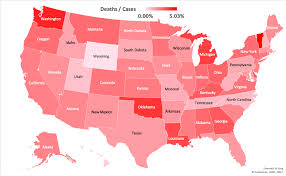 Try staring at the NY Times list and its murky map. The NY Times decided that tracking down and mapping the list of nursing home deaths nationwide required more than 30 contributing writers for the story. The ‘Nursing Homes in Crisis’ collection is about Covid-19 in 2020. Actually in each recent year, the New York Times has looked at nursing homes and found them to be a problem in 2017, wanting for a great deal in 2018, just a bit in 2019, then an onslaught of investigation most recently. Amid the outcry, the negative comments about bad management, bad physical design of the buildings, bad for-profit ownership, bad Covid-19 testing, etc., etc. -- very little deep thought about why people live there and what change is likely.
Try staring at the NY Times list and its murky map. The NY Times decided that tracking down and mapping the list of nursing home deaths nationwide required more than 30 contributing writers for the story. The ‘Nursing Homes in Crisis’ collection is about Covid-19 in 2020. Actually in each recent year, the New York Times has looked at nursing homes and found them to be a problem in 2017, wanting for a great deal in 2018, just a bit in 2019, then an onslaught of investigation most recently. Amid the outcry, the negative comments about bad management, bad physical design of the buildings, bad for-profit ownership, bad Covid-19 testing, etc., etc. -- very little deep thought about why people live there and what change is likely.
Why are people in nursing homes? You probably know the reasons -- but let us recap. Women make up the majority of nursing home residents. Past age 75 single women are likely to rely on Social Security for income, not enough to afford assisted living, now north of $48K per year. If they live in assisted living, at some point they can’t pay the bill or are a problem for staff, so they can be ejected – sometimes to a family member, but typically to a nursing home, where the average duration of stay is 2.5 years. So up to 70% of nursing home residents are women, either widowed, single, or having spent down assets with the assistance of an attorney to qualify for Medicaid, the primary payer for nursing homes. Half of these women have no close relatives. They may be disabled or have significant chronic conditions, including dementia.
When the customer does not advocate for self... Despite years of media rage about conditions in nursing homes (see 2018, above), nothing is really done about those that provide poor care. In the well-run nursing homes during non-pandemic times, family visitors are often seen, as well as volunteers from religious organizations, local high schools, charities, and pet therapists to visit those without families. On the other hand, as the Covid-19 pandemic began, nursing homes were generally in poor shape – and those with low-star ratings were in worse shape. Keep in mind that the inspection process that produced those ratings is typically annual. There are new attempts to inspect more frequently to look for contributors that led to the incidence of Covid-19 (following the Kirkland, WA disaster). But realistically how will that process change, given that it is typically done by state health agencies, which are not likely to be overstaffed?
…Lawyers are at the ready. Note that the nursing home 'industry' is pushing for immunity from liability for the recent deaths – an immunity that seems to have made it into the New York State budget, but may be repealed. In New Jersey, though, a class action lawsuit has already been filed for the nursing home that had the makeshift morgue. Note that wrongful death lawsuits have the biggest (up to $43 million) payout. So let's ask -- following the senate testimony and when the dust settles on the nursing home disasters of 2020, what will have fundamentally changed, either in the composition of residents, the payment mechanics, the corporate structure of the industry, the degree of transparancy, the role of lawyers, the public’s interest, level of oversight or the media outrage?
